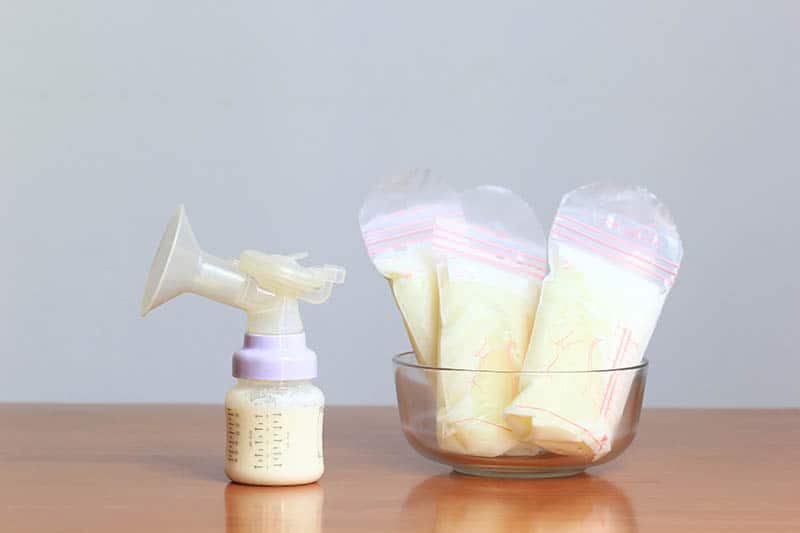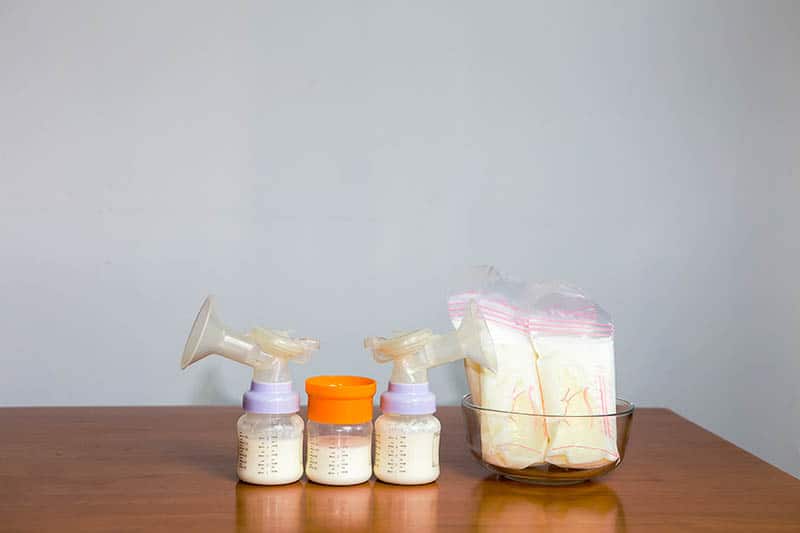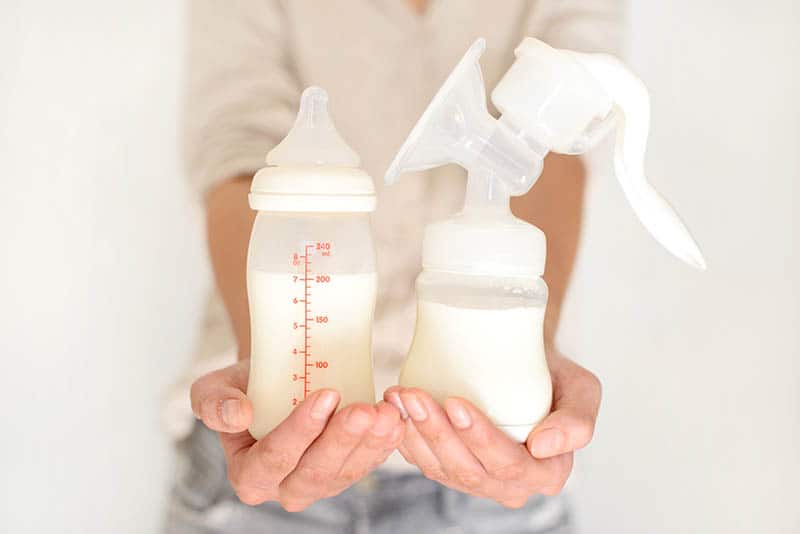Breastfeeding puts a huge energy demand on your body, and while some mothers may have a lot of time to breastfeed, it does not always work flawlessly for everyone.
One of the biggest issues among modern moms is their milk supply.
It can sometimes be frustrating for mothers if they cannot produce enough milk for their growing babies.
Some mothers find themselves desperately in need of a couple of ounces more every day. Power pumping is a great option for moms who require a boost to their milk supply.
Breast pumping does not have to be difficult; some women however find it challenging.
When you are a busy woman, trying to balance work with breastfeeding and other duties might very well seem like a hassle.
It is particularly frustrating if you are not producing much milk in every session for your little one.
According to an International Board Certified Lactation Consultant (IBCLC), power pumping can get you great results in a relatively short period.
However, there are several essential facts that you need to know before trying it.
RELATED: Breast Pumping Gear: 11 Absolute Essentials for Pumping Moms
What is power pumping?

You may have already heard of it but do not know how it works and its efficiency. It works brilliantly to improve your milk supply.
It makes your body produce more milk by stimulating cluster pumping (when the baby suckles frequently).
While power pumping is a great option to improve milk production, it should not replace regular nursing.
It is meant to be an addition to the daily nursing routine.
To efficiently perform it, set aside one hour with no interruptions, preferably in the morning since this is when most mothers have the highest milk supply.
If you are nursing, plan your power pumping schedule after the nursing session.
In one hour, you could pump for two twenty-minute sessions, resting for ten minutes after each session.
Then pump for one more 10-minute session.
Follow your regular nursing or pumping routine for the rest of the day. While some moms prefer doing it twice a day, once should be sufficient.
You are likely going to start seeing results if you do this for two or three consecutive days.
The period you will have to wait before seeing results varies across different body types.
The 2-3 days mentioned above is just a guideline.
Some women say they start seeing results after 4-7 days, while others do not notice any changes.
Cut out the power pumping sessions once you notice some significant changes until you feel the need for another boost.
Does power pumping really work?

Since it requires a large time commitment on your part, it is quite reasonable to want to be sure of its efficiency and applicability.
The success of consecutive power pumping sessions depends on a few factors:
How old your child is: The older your child is, the more your breasts have established your milk supply. It, therefore, takes longer to notice any positive or negative changes as a result of pumping.
At a certain point in time, power pumping may not help improve the quantity of your breast milk.
How effective the milk trickling is during power pumping: The purpose of it is to empty your breasts frequently.
That leads to faster milk production. Full breasts signify low milk supply. You have less chance of success using power pumps if your breasts are not fully emptied during pumping.
It is therefore recommended that you drain your breasts fully by adopting hands-on pumping methods.
How long you are willing to do your power pumping sessions: If you only power pump for a day and then quit, you might not notice any changes to your milk supply.
The fastest result noted is after two days of power pumping. However, some moms only notice results after one or two weeks of continuous pumping.
The mother’s body limitations: Some moms have inadequate milk-creating cells in their breasts, which is popularly referred to as insufficient glandular tissue (IGT).
These moms experience milk supply limitations due to their body’s inability to make more milk.
While it does not guarantee as full a milk supply as in other moms, the only action moms with a low milk supply can take is increasing their power pumping frequency.
If your shortage of milk continues, it is recommended that you see a lactation consultant for a proper breastfeeding assessment.
This can help you determine the next step to achieving your goals.
How much milk should I pump?

During a regular pumping session, most mothers pump up to 2 ounces of milk.
Getting 0.25 ounces from each boob after a day is totally normal.
You might, however, be stressed about pumping enough baby milk for the next day, particularly if you are providing bottles for a whole day of child care.
The stress could lower your milk production and create a cycle that seemingly sucks you dry every day.
To prevent the panic of handing your last bag of frozen milk to your babysitter, you should try stockpiling milk.
By pumping your breasts for an hour, you can successfully establish a stronger milk supply to take care of the next day’s demand.
After pumping, make sure you put the milk in the freezer to begin a freezer stash that can offer you that essential breather when your body does not seem to respond to the power pump.
It is totally acceptable to get only a few drops during power pumping.
The goal is not to accumulate a huge volume of milk instantly, but rather to signal to your body to make more milk.
Which type of Power Pump is the best?
There are hordes of electric pumps available on the market. Irrespective of which guidelines you are following, a double electric breast pump usually provides the most exclusive pumping.
It is recommended for its ability to remove milk from both breasts simultaneously.
Double pumping, according to experts, increases your prolactin levels significantly, which is essential for mothers looking to improve or maintain their milk supply as compared to a single pump.
Increasing milk supply is possible using a single breast pump, however, you have to eliminate the rest period to be able to switch between the two breasts.
Some mothers might find it hectic to switch between both breasts, but in return, they get purchase their equipment at a more affordable price.
Double breast pumps are equal to the simulation of two babies latching on your breasts simultaneously. That can significantly boost supply.
Some of the best pumps on the market include:
| Image | Title | Price | Prime | Buy |
|---|---|---|---|---|
 | Medela Pump in Style Advanced with Tote | PrimeEligible | Buy Now | |
 | Spectra Baby USA - S1 Plus Premier Rechargeable Electric Breast Pump | PrimeEligible | Buy Now | |
 | Elvie Pump Double Silent Wearable Breast Pump with App | PrimeEligible | Buy Now |
But if you’re looking for some cheaper alternatives, here are my top picks:
| Image | Title | Price | Prime | Buy |
|---|---|---|---|---|
 | NCVI Double Electric Breast Pump | PrimeEligible | Buy Now | |
 | IKARE Double Breast Pump | PrimeEligible | Buy Now | |
 | Bellababy MiniO Breast Pump | PrimeEligible | Buy Now |
RELATED: Spectra Vs Medela: Which Breast Pump Is Better For You?
How long does it take to improve milk supply?

Every mother has a different body type; hence the amount of time required to notice changes differs.
However, on average, most moms have to power pump once or twice a day for a period of four to seven days to start noticing any significant changes.
Once you are satisfied with your level of milk, you can ease off on power pumping sessions until you feel the need to raise supply again.
Some mothers do not respond positively to power pumps.
This method might not be the most efficient in this case. It is best to talk to a lactation expert to know the possible alternatives to improve your milk supply.
For the best results, make sure you are in a room where you cannot be interrupted during the sessions.
Looking at a picture of your child while you pump or smelling their blanket can help you produce more ounces of milk.
You could listen to your baby cry as well.
Before attaching the pump to your breasts, try hand expressing some milk for a while to help you relax.
It can also offer you the skin-to-skin feeling that makes milk let down much more efficiently and comfortably.
Is it necessary to power pump at night?

If your child is surprisingly sleeping through the night and you are unsure of whether to pump at night or wake them to avoid a drop in your milk supply, it may be hectic to make up your mind leading to stress.
This is especially true if you are having issues with your milk levels.
According to Kellymom, newborns typically suckle 8-12 times in a day.
It is therefore recommended that you pump at least every three hours and at most three until the preferred supply level is achieved.
The best way to make sure that you are mimicking the child’s nursing program is to pump whenever your child eats.
The routine could be: change the baby, attempt to breastfeed him, bottle feed him, then power pump while his daddy burps him.
You should be looking to pump 25 ounces on average every seven to ten days.
If you have more than one infant, you should aim to produce 27-32 ounces of milk in 14 days postpartum.
A newborn baby drinks 1.5 to 3 ounces of breast milk per nursing session.
For older babies, it is a good idea to pump once in the course of the night for the first few months.
You can also dream feed at night if you notice a drop.
Most lactation consultants and experienced moms recommend power pumping once between 1 am and 4 am, as breast milk supply tends to be high at this time.
As your child grows older, you can space out your pumping sessions further and drop some, including the hectic ones in the middle of the night.
That is because the infant continually feeds more as he grows up and can stay longer before the next nursing.
You will also need to reduce the pumping when your child starts feeding on more and more solid foods and less milk.
Night nursing is excellent for your infant’s milk supply, but you do not have to get out of your bed if they are sleeping peacefully through the night.
If the baby is growing fine, does not have any medical issue, and has enough wet and dry diapers, there is no need to wake them to feed.
Give them time to sleep and enjoy some sleep yourself.
Your baby will most likely need to feed a lot after a long night’s sleep. However, pumping essentially tells your body that more milk is required.
If your child is not feeding enough after sleep while you pumped during bedtime, it could potentially lead to a milk oversupply.
Hand express a few drops of milk or simply pump off a little for some relief if you feel uncomfortable to get up and power pump in the middle of the night.
Reasons to avoid power pumping

Unless you have seen a lactation expert, you should try to avoid using this method of breast pumping.
Moreover, if you are not experiencing any milk supply problems, using power pumps could lead to an oversupply, which is just as stressful if not more so than an undersupply.
You should also check the pump parts to make sure they are working in perfect condition before starting to use the tool.
A milk oversupply can:
- Cause the baby to resist suckling during milk letdown.
- Cause your baby gas and tummy problems by making him gulp air.
- Cause painful engorgement.
- Make your child spit up frequently.
- Give the baby explosive stools.
- Breastfeeding is an emotional process.
You need to make sure your baby is getting the most that you can offer without doing harm to your body.
While in most cases there is nothing wrong with your milk supply, most women do not believe that they are providing their baby with the right amount of milk.
It is entirely normal to be unable to fill your bottles during each pumping session. It is also not unusual for your level to vary from day to day.
You could alternatively use Fenugreek seeds and other food that increases milk production, coconut oil, or lactation cookies which, though not as fast as power pumping, will eventually get your milk production levels up.
Factors that could contribute to low supply:
- An old or malfunctioning breast pump.
- You are not relaxed enough during your breast pumping sessions.
- You misguidedly assume that the amount of milk that you pump is the amount that your infant should get when he or she nurses.
- You have a small breast flange.
- You are not eating and drinking as you ought to.
If you still feel concerned about the amount of milk that you are producing for your infant, do not worry yourself.
It is very rare for a mother to have a breast issue that seriously reduces her milk supply.
Most problems are solved by consulting a qualified lactation professional.
It is, however, essential to remember to take good care of yourself.
Having a robust immune system and frequent breaks from your working station can go a long way in reducing your stress and allowing your body to generate energy to feed your infant properly.
Make sure the pump flange size is also comfortable for you as it could cause more discomfort as you continue to use it.
Have it exchanged for one with a larger or smaller pumping flange if you feel uncomfortable using the pump.
However hectic it might be, it is the responsibility of every mother to breastfeed her infant irrespective of whether they have to supplement their current milk supply.
According to Medela, there is no need to pressure your body to produce more milk in the first four weeks of breastfeeding.
It is therefore advisable to take your time and seek the opinion of a professional lactation officer.
PS – If you want to make sure you’re pumping enough milk when you’re on the go, you’re going to need a breast pump bag. Here are our top picks:
| Image | Title | Price | Prime | Buy |
|---|---|---|---|---|
 Top
Top | Sarah Wells Lizzy Breast Pump Bag (Le Floral) | Prime | Buy Now | |
 Top
Top | Bananafish Electric Breast Pump Backpack | PrimeEligible | Buy Now | |
 Top
Top | mommore Breast Pump Bag | PrimeEligible | Buy Now | |
 | Lunies Breast Pump Bag | PrimeEligible | Buy Now |
Like this article? Please share or pin it for later. You can also stay in the loop and follow us on Facebook, Instagram or Pinterest.

We love honesty! Find Your Mom Tribe is an Amazon Associate and we earn from qualifying purchases through affiliate links at no extra cost to you. Please see our full Amazon Affiliate disclosure for more information.

